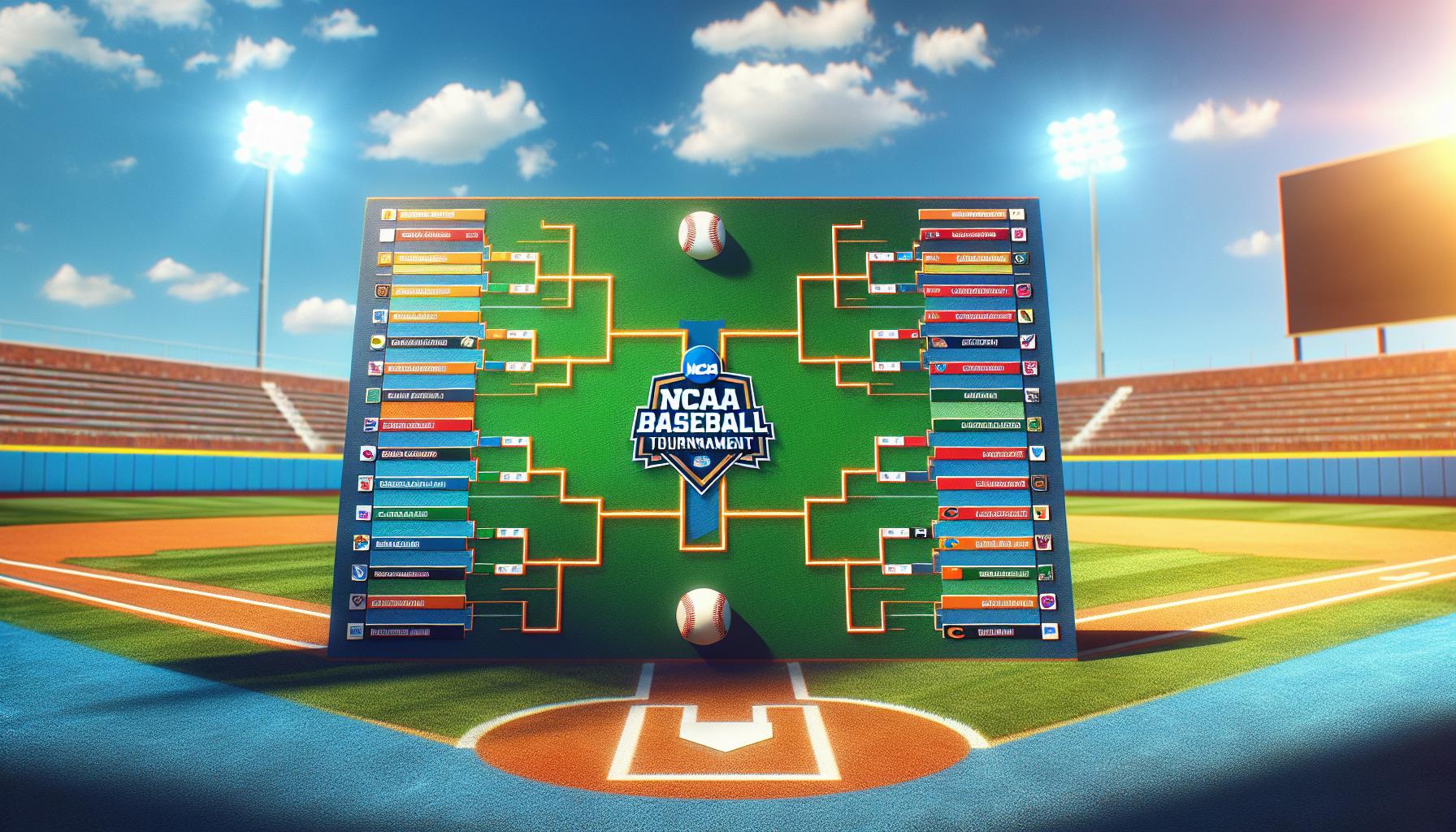Phone:
(701)814-6992
Physical address:
6296 Donnelly Plaza
Ratkeville, Bahamas.

As a die-hard college baseball fan, I’ve spent countless hours analyzing NCAA baseball brackets and following the thrilling journey to Omaha. The NCAA Division I Baseball Tournament, often called the Road to Omaha, brings together 64 of the nation’s top teams in an electrifying battle for college baseball supremacy.
I’ve learned that understanding the tournament’s structure is crucial for both newcomers and seasoned fans. The bracket begins with 16 regional tournaments, each featuring four teams in a double-elimination format. The winners advance to the Super Regionals, where the excitement intensifies as teams compete in best-of-three series. Ultimately, eight teams earn their spot in the College World Series, where dreams of national championship glory become reality at the iconic Charles Schwab Field in Omaha, Nebraska.

The 2024 NCAA baseball tournament features dominant programs that consistently rank in the top 25 RPI rankings. These teams demonstrate exceptional performance metrics in both conference play and non-conference matchups.
Louisiana State University leads the pack with a .750 winning percentage in SEC conference games. Wake Forest maintains its position as a top seed with 40+ regular season wins, while Tennessee boasts the highest team batting average at .328. Here’s how the traditional powerhouses stack up:
| Team | Conference | Win % | Key Stat |
|---|---|---|---|
| LSU | SEC | .750 | 1.89 Team ERA |
| Wake Forest | ACC | .720 | 98 Home Runs |
| Tennessee | SEC | .695 | .328 Team BA |
| Florida | SEC | .685 | 45 Regular Season Wins |
| Stanford | PAC-12 | .680 | .981 Fielding % |

The NCAA Division I Baseball Tournament’s regional host sites represent premier college baseball facilities across the United States. These venues combine state-of-the-art amenities with rich baseball traditions to create optimal tournament environments.
| Venue | Capacity | Key Features |
|---|---|---|
| Alex Box Stadium | 10,326 | LED lighting, natural grass |
| Carolina Stadium | 6,400 | 360° concourse |
| Swayze Field | 11,477 | Student section |
| Klein Field | 4,000 | Premium sightlines |
| Condron Ballpark | 7,000 | Climate control |
Each regional host site undergoes rigorous evaluation based on:

The NCAA baseball tournament bracket follows a structured format combining regional double-elimination play with best-of-three Super Regional matchups. I’ll explain the key components that make up this comprehensive tournament system.
Each regional bracket contains four teams seeded 1-4 based on specific performance metrics. The top 16 national seeds host their regional tournaments, with the #1 overall seed facing the weakest #4 seed in their bracket. Here’s how the seeding criteria breaks down:
| Seeding Factor | Weight |
|---|---|
| RPI Ranking | 40% |
| Conference Record | 30% |
| Head-to-Head Results | 20% |
| Last 10 Games | 10% |
Teams advance through the bracket by winning their respective double-elimination regional tournaments. The advancement process follows these key guidelines:
Teams that lose twice in regional play face elimination, while undefeated teams require only one additional win to advance. Super Regional matchups pit regional champions against each other in a three-game series, with higher seeds hosting all games.
The NCAA baseball tournament has produced remarkable achievements that have shaped college baseball history. These moments showcase the tournament’s ability to create lasting legacies through unexpected victories and dominant performances.
Fresno State’s 2008 championship run stands as the defining Cinderella story in NCAA baseball tournament history. As a No. 4 regional seed with a regular season record of 33-27, the Bulldogs defeated No. 3 Arizona State, No. 6 Rice, and No. 8 Georgia to claim the national title, becoming the lowest-seeded team to win the championship.
Historic underdog achievements include:
| Year | Underdog Team | Starting Seed | Final Result |
|---|---|---|---|
| 2008 | Fresno State | No. 4 Regional | National Champions |
| 2012 | Kent State | No. 3 Regional | CWS Appearance |
| 2012 | Stony Brook | No. 4 Regional | CWS Appearance |
| 2017 | Davidson | No. 4 Regional | Super Regional |
These unexpected tournament runs demonstrate the competitive balance in college baseball, with lower-seeded teams proving their ability to compete against traditional powerhouses on the national stage. Each underdog story features signature moments: Fresno State’s elimination game victories, Stony Brook’s dramatic super regional win at LSU’s Alex Box Stadium, Kent State’s regional clincher against Oregon.
The College World Series (CWS) employs a distinctive double-bracket format at Charles Schwab Field in Omaha. The eight qualifying teams split into two groups of four, competing in double-elimination brackets that determine the championship series participants.
| Round | Number of Games | Format | Time Frame |
|---|---|---|---|
| Opening Round | 4 games | Double Elimination | Days 1-2 |
| Bracket Play | 4-6 games | Double Elimination | Days 3-6 |
| Finals | 2-3 games | Best-of-Three | Days 7-9 |
The championship format creates intense competition through strategic pitching rotations depth management. Teams must navigate multiple games while preserving key players for potential championship matchups.
I’ve found that understanding the NCAA baseball tournament bracket system opens up a whole new level of excitement for college baseball fans. The journey from regional tournaments to Omaha showcases the best of collegiate athletics through intense competition and unforgettable moments.
Whether you’re tracking your favorite team’s path or following a thrilling Cinderella story I believe the tournament’s format creates the perfect balance of opportunity and challenge for every participating program.
I’m confident that this comprehensive look at the NCAA baseball bracket structure will help you navigate and enjoy one of college sports’ most exciting events. Remember that in baseball anything can happen – that’s what makes the Road to Omaha such a special part of America’s pastime.